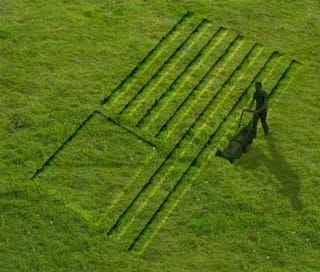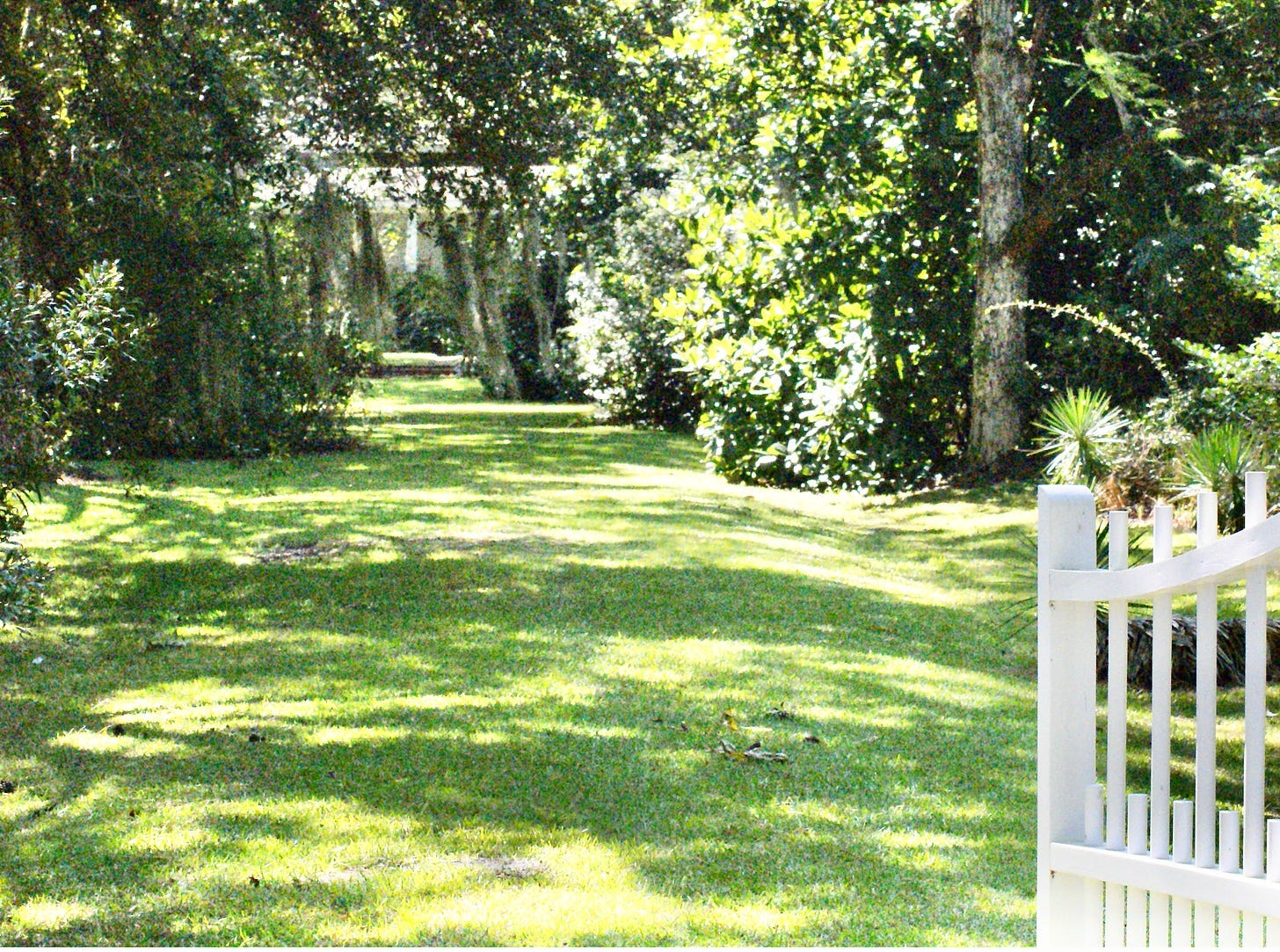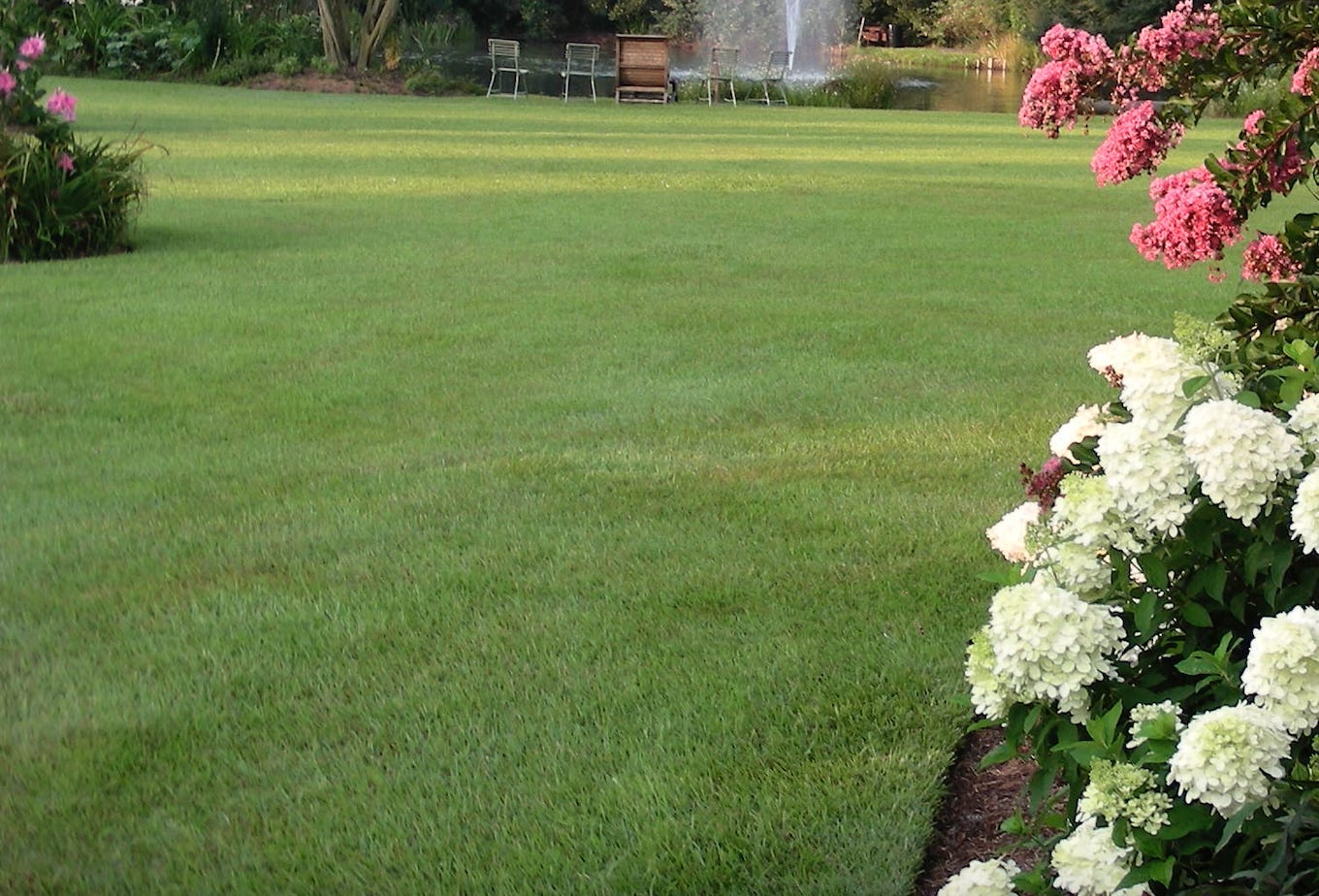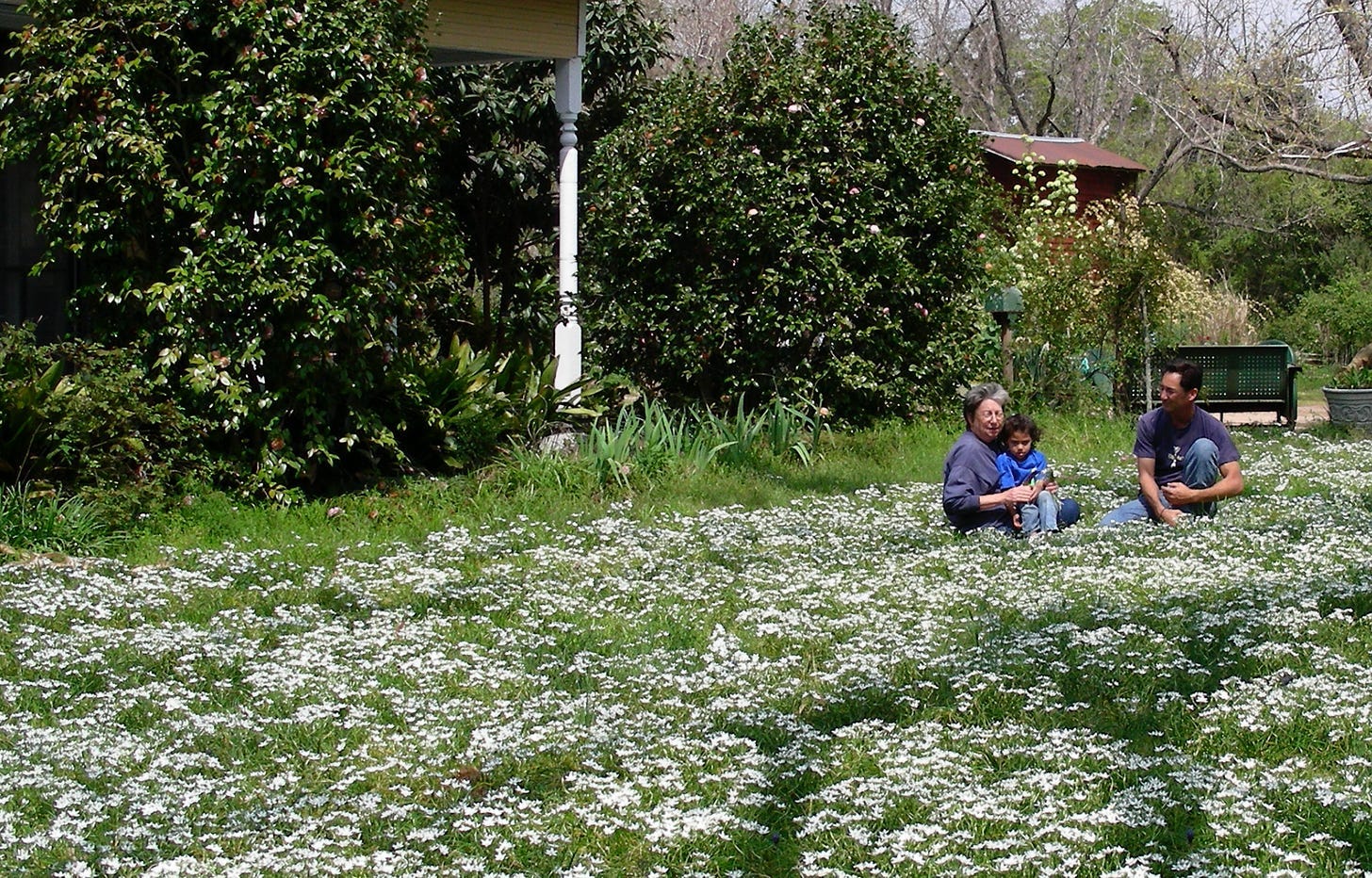The Polarization of Lawns & Grass
The History of Sustainable Southern Lawns Has Been Subjugated. It’s time to be proud of our eco-friendly lawns.
“Stop. Take a break. You've been doing this for two hours," Jennifer said. She wore a black dress and heels in the sweltering August heat. A new Southerner, a recent New Yorker, Jennifer was still adjusting to her new home. She didn't quite understand this wake or reception—whatever you call the afterparty of a Southern funeral—or why it was held in the hot, crispy yard. Another mourner stepped up to shake my hand, but Jennifer turned him away. "He needs a minute. We're going to get some water," she said, leading me away.
Head down, I watched my shiny black shoes crunching tan grass. Gray-leafed weeds and a stunted lavender sage leaf clung to life. As if I'd asked her a question, Jennifer remarked, "Honestly, I'm glad you didn't water the lawn. My heels don't sink in this hard ground."
For decades, Daddy made this yard a place for gatherings, a place to roll out a slip-n-slide, and a spot vitally important for the dogs. Its useful flatness and walkability make it an outdoor room. That flatness makes it appear uniform, but there's no true uniformity. On close inspection, you see it's actually a mosaic of grass and dozens of different little plants, all kept dwarfed by the mower. This should be the highest standard for lawns.
As a teen, mowing yards meant money. In the early '80s, I was the go-to grass-cutting boy. Back then, no one had irrigation or used chemicals to kill weeds, and only a few people added fertilizer. Most folks didn't have the money or inclination for that sort of thing and wouldn't have wasted it if they had it. This isn't wistful reminiscing; this is experience talking. I knew the yards of trailers, plywood houses, mansions, and cemeteries. The standard mix included centipede grass but also wood sorrel, dandelions, lyre-leaf sage, sour grass, and southern violets. I learned a lot about tiny plants, insects, and birds while I mowed. I noticed caterpillars, flies, burrowing wasps, and mole tracks. Cowbirds followed me to spear grasshoppers and toads.
Daddy taught through experience that muscle and effort could be turned into money. He instilled a work-hard-and-save philosophy that paid off beautifully for him. He also made sure that in that work, I observed the cycles of nature, the critters, beasts, and birds on the lawn. At heart, he was a conservationist.
This kind of yard is a testament to an age of practical wisdom. In our endless quests to do better, these kinds of yards have garnered disdain. It's time to give them their due, to remember and resurrect old-school, sustainable lawns.
Finding Middle Ground in Modern Lawn Debate
Today, lawns are as controversial as drag shows, abortions, and Oxford commas.
Lawn-haters belittle lawn lovers with disdainful social media memes. They share ideas for meadows, natural areas and walkable groundcovers. “Bring Nature Back!” they plead from laptops in air-conditioned home offices. “Moms Against Monoculture!”
They forget that ‘lawns’ used to be diverse. “Make America Mow What Grows–Again!” I want to chime in.
At the same time, neighborhood associations set standards for sprawling controlled monocultures of grass, golf lovers swoon over high-def carpets of green and real estate agents suggest that a perfect lawn implies a well cared for house.
Today, depending on perspective, perfect lawns are status symbols for some, derision for others. Lawns weren’t always this way – at least not where I’m from, the Deep South.
Let’s drop the loaded words. We need flat places outside. Soft, green, functional spaces absorb rain, protect from fire, and can be as they used to be, beautifully diverse and sustainable.
I’ve spent decades of my horticulture career using low-impact lawns that make lots of people happy. I’ve done it for small homes and on large estates. Once, I even built a brand new, 70-acre botanical garden with only two small lawns — both enjoyed by a million people a year for events, picnics, hula hooping, and quiet time.
We can have diverse, eco-friendly lawns using tested techniques simply by going back to the way we used to do grass.
Old Southern Yards
My own parents’ yard has been a lawn since at least the 50s. That’s the oldest dated photo we have. The sunny part was (and still is) mostly zoysia, and the shady part was a centipede. It had all the plants mentioned above but is more diverse as, over its hundred-plus years, generations of gardeners added bulbs; grape hyacinth, jonquils, sorrel and red spider lilies, and American garlic. We call it the bulb lawn. In spring, ankle-deep flowers cover it, but in summer, it’s the useful flat, mowable space that was, on that August afternoon, perfect for Daddy’s wake.
Subverted by Social Changes, Pretense & Money
In hot climates, the yard is an escape from a hot house. As long as it's flat and tidy, it’s fine. My mixed yard, even when crispy in August, is more beautiful, used more and is more prestigious than any golf club boasts.
Social and economic conditions changed the use and expectation of grass. Lifestyles presented on tv garden shows present perfect lawns. Real estate developers roll out instant lawns. Air conditioning, TVs, and bigger houses keep people inside more. We spent less time on the grass as houses grew more comfortable and spacious. Our relationship with grass changed.
Since we paid less attention to it and used it less and less, you might think expectations of grass might be lowered. Or that we'd need less of it. But the opposite happened. People started wanting fancy grass. Golf course style grass. Carpet-like monocultures. Grass got pretentious. People like perfect lawns.
Our rural grandparents, humble or high, may have been content with an easy, diverse mixed yard. But when subsequent generations moved into the suburbs, they sought to distinguish themselves from the country. As new people moved into the South, from places with different, ‘higher’ lawn standards, the idea of the perfect lawn was reinforced. Acres of mono-lawn became the norm.
Your Mono-lawn Kills My Fish
It surprises some people that as a garden designer, I firmly believe beauty is in the eye of the beholder. I'm a live-and-let-live kind of guy. But the idea of the perfect lawn doesn't allow for coexistence. To have a perfect lawn, one person must infringe on the rights and health of others.
A perfectly groomed mono-lawn needs an irrigation system. Most, no matter how precisely timed, waste our water. Every time I see the irrigation system at our new local fast food joint spraying into the road, my heart breaks for Dominican friends who carry open buckets of drinking water for miles. From an environmental standpoint, groundwater is already threatened by overuse. Even in our rain-laden climate, in nearby Hilton Head, SC, overuse of groundwater leads to saltwater intrusion, making the water too salty for plants or human consumption.
In our climate, most grasses survive even the hottest, driest summers. No need to worry about it. It will grow when it rains. Accepting this may take a change of expectation and a release of pretension. In drought, the normal response of grass is to turn brown. It even feels crispy to us. Don't worry. It will be okay.
Most monoculture lawns get regular herbicide applications. There are low-impact options, but they are rarely used. One common turf herbicide is proven to cause the testicles of young frogs to shrink and disappear. Frogs and other amphibians are indicator species, critical to watch as signs of ecosystem health. This is more than a local problem. The chemical in question, used on big turf and in big agriculture, is found in about 70% of US groundwater. You're probably drinking or brushing your teeth with it. Who wants to see children, dogs, or friends playing barefoot on that?
Some pesticides and herbicides stay in the soil for months. But many move with rain into groundwater. Since we're all connected by water, one man's new fancy grass poisons me and plenty of wild animals and plants too.
Monoculture lawns pollute our clean water with synthetic fertilizers too. Nitrogen, the most common element in a bag of fertilizer, is also the most problematic. When you sprinkle it out, the grassroots absorb some. But after the first rain, the rest runs through the soil and into our common water. Nitrate pollution comes from various sources, but the one we can easily control, the one that's unnecessary, is literally in our backyards.
I designed a garden on a local island, facing a marsh. We used frogfruit and sunshine mimosa instead of turf. When the tide goes out, fiddler crabs run through marsh grass. But I can look down the marsh and tell who over-fertilizes. In front of those yards, the marsh vegetation is gigantic, thick, and dark green, stimulated by fertilizer runoff. It's often too dense for fiddler crabs to live under.
On a grand scale, excess nitrates cause massive algae blooms in lakes and the ocean, killing marine life. Excess nitrogen causes waterways and ecosystems to destabilize. Across the Atlantic, environmentally conscious Holland's Minister for Nature and Nitrogen Policy monitors nitrogen pollution, which should be considered as thoroughly as we consider our carbon footprint.
BACK TO SEEING LAWNS AS DIVERSE AND BEAUTIFUL.
Everything cycles. The current trend toward monoculture lawns is being eroded by renewed interest in natural spaces—which, by the way, were a hallmark of the 1970s design style of original coastal developments. We must recognize and build on that, but without shaming people either way.
My Mother, who grew up sweeping her yard in the 40s, says, “I’d never want to go back to sweeping the yard! I love that we have grass now.” She still has that mixed lawn, weeds, bugs, bulbs, and all. She loves that. She gets that it provides for birds and wildlife. But she likes that it’s useful too. Momma doesn’t want a meadow. She can’t take care of one. She’s proud of the weeds and cherishes the memories of weddings and funerals that happened out there.
The other day, when I was writing this, I asked my friend Jennifer to remember that day of my Daddy’s funeral, her first southern wake. We teared up a bit, then she laughed and told a story of her memory. That lawn, dry and brown as it was, did exactly what it was supposed to do. Neither of us remembered one single weed or one single dismissive comment about it.
You can be, too. Here are some facts about the old-school lawn:
It‘s never had an irrigation system.
It’s a diverse ecosystem. I’ve counted about 30 species of plants in it including southern violet, American strawberry, American garlic, and plenty of other native plants. Drawn to the lawn for nectar, it sustains butterflies, moths, and European honeybees, ants, birds and critters I never see.
It’s not had synthetic fertilizer since the 1960s. If at all.
It’s never had a herbicide application.
It’s beautiful in the spring when thousands of bulbs flower.
It’s functional most of the year.
It requires mowing about once every three weeks from April through August.
Birds love it – it's the perfect hunting and foraging place for them.
If you’d like to know more about the history and species in this lawn, there’s a story in my book Funky Little Flower Farm about the bulb lawn.
Ready to Go Back? Tips on Transitioning from Mono-Lawn to Old-School Lawn.
Relax. Embrace diversity. Let some weeds grow. If you live in a community with ‘Lawn Standards,’ get on the board and rewrite them. We, nor the animals and plants we should be stewards of, nor our grandchildren, can afford to let a few pretentious, uninformed monoculture lovers set our standards.
Plant some tiny bulbs. My favorite no-fail bulb to plant into a lawn is Muscari neglectum. Plant in October.
Seed in micro-clover. It will have little white flowers in spring but more importantly, it provides nitrogen to your grass.
Eliminate or reduce irrigation. Most grasses are fine with one inch of water twice a month. Remember, in our driest month, August, it’s better to let the lawn go crispy than to give it a bit of water here and there.
Quit herbicides and pesticides. Just quit.
Brace for the transition. This is a slow and sometimes frustrating process.
It’s Ok to Enjoy to Enjoy Your Grass
Like my father, I’m a conservationist. I’m imprinted and in love with the Southern wilds. I am also a horticulturist and a garden designer. I understand that we need flat, useful lawns. We have to shatter two myths of this current lawn debate. First, that lawns were ever or should be monocultures. Second, that all lawns are bad for the environment. We have a history of the solution; we have a blueprint for beautiful, sustainable lawns. Let go of the dogma, relax, and learn to love and mow what grows.







Yes, you hit the sweet spot on this issue. I've read entire books about eliminating lawn, and they claim that an ornamental garden is less work and less money. It's only less money if you were pouring money into making and keeping the lawn a monoculture. And if you don't have the knowledge, time, or physical capability to maintain an ornamental garden, it's far easier to find and less expensive to pay someone to cut the grass than to weed a perennial border or even prune shrubs. As I mention in this blog post (https://www.coldclimategardening.com/2017/06/28/the-flowery-lawn/), Ken Druse in his book A Passion for Gardening calls our type of lawn a "cropped meadow." That makes it sound properly upscale, ecological, and sustainable. Nevermind it's also old-fashioned. Vintage? Heritage! I'm calling my lawn a heritage lawn. Oh, I think in Minnesota they call it a bee lawn.
This article couldn’t come at a more important time for me. When I started landscaping, I was a “no grass” designer. As I’ve learned but more importantly seen and lived with old Southern yards I have done a 180 turn. In my new home we have about 6 acres of monoculture turf that is watered and sprayed with pesticides, herbicides, and weed killers. I have stopped all this and am trying to move to a green space that allows the little children to have violet fights (something my partner and his brother did as children in their grandmother’s yard), allows the bees and other critters to thrive, and for it to get crisp and brown in August. Thanks Jenks for reminding me that the old way is the best way to keep, nurture, enjoy, and be good stewards to lawns.